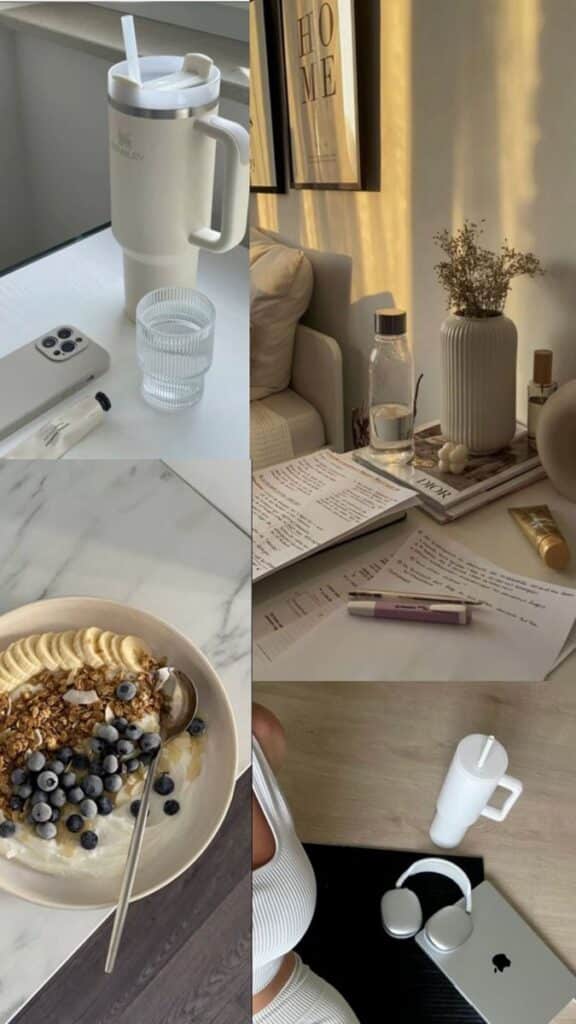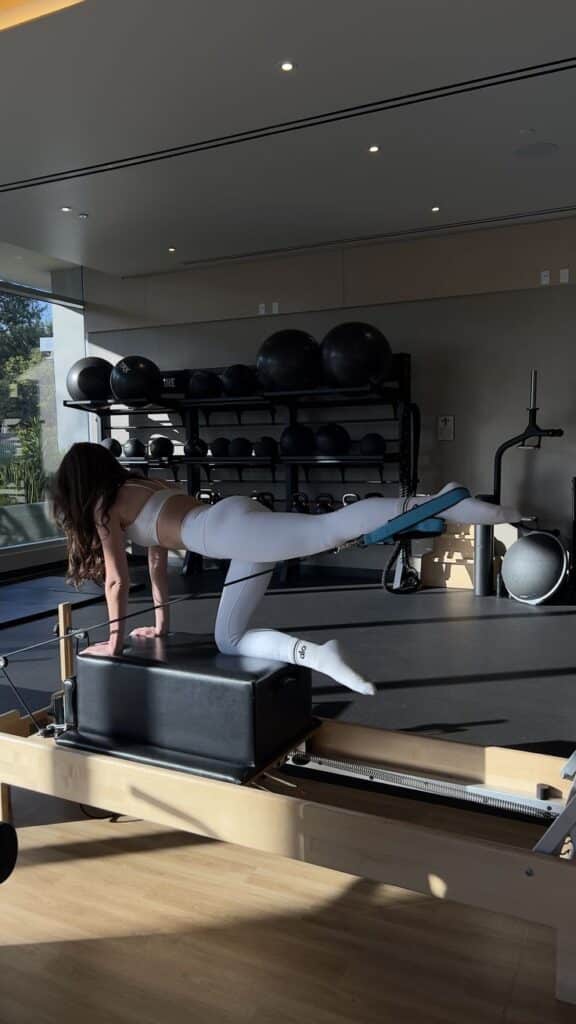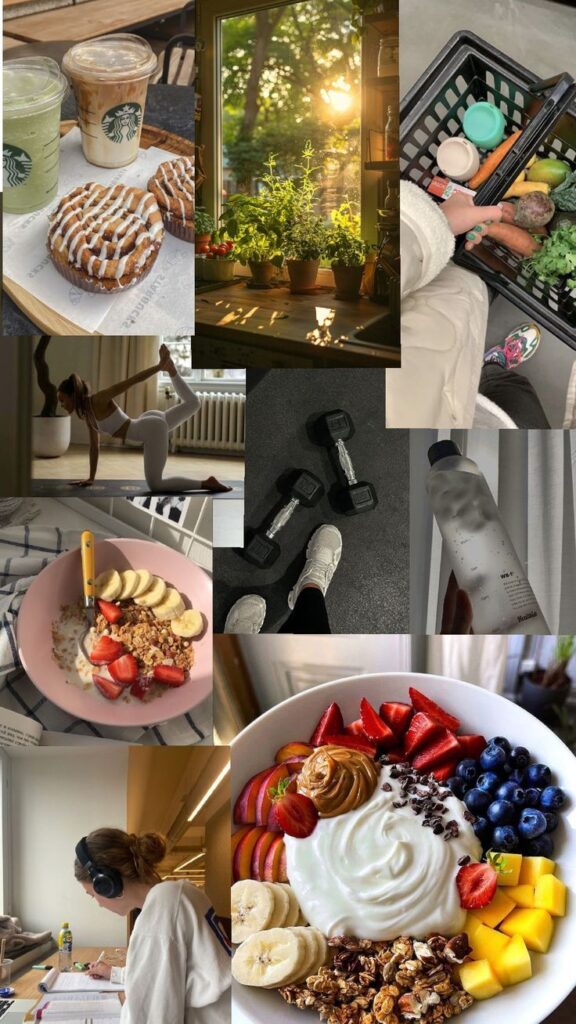Daily habits shape who you become more than any single dramatic change ever could. The small actions you repeat consistently create lasting improvements in your health, relationships, career, and overall happiness.
When practiced regularly, simple habits can transform your life by building positive momentum that compounds over time. You don’t need to overhaul everything at once to see meaningful results. Small changes in areas like your morning routine, physical activity, learning, and mindfulness can create significant shifts in how you feel and what you accomplish each day.
1) Drink at least 8 glasses of water daily
The “8 glasses a day” rule suggests drinking eight 8-ounce glasses of water daily. This equals about 2 liters or half a gallon of water.
Your body needs water for basic functions like flushing toxins and maintaining proper hydration. Nearly four out of five American adults drink fewer than eight glasses per day.
Start your morning by drinking two glasses before your first cup of coffee. This helps kickstart your hydration for the day.
Drink at least one glass of water with each meal. This simple habit ensures you get several glasses without extra effort.
Set reminders on your phone until drinking water becomes automatic. You can also connect water drinking to habits you already have established.
If you drink alcohol, have at least one glass of water for every alcoholic drink. This helps maintain your hydration levels.
Your individual water needs may vary based on your age, activity level, and climate. The 8-glass rule serves as a helpful starting point for most healthy adults.


2) Wake up 30 minutes earlier to start your day calmly
Waking up just 30 minutes earlier creates precious quiet time before the world demands your attention. This small change gives you space to breathe and prepare mentally for the day ahead.
Those extra minutes allow you to move at your own pace instead of rushing through your morning routine. You can enjoy a peaceful cup of coffee or tea without checking the clock constantly.
Early morning hours offer natural stillness that’s hard to find later in the day. The quiet atmosphere helps you think clearly and set positive intentions.
You can use this time for activities that nourish your mind and body. Consider gentle stretching, reading a few pages of a book, or simply sitting in silence.
Starting your day calmly reduces stress and anxiety that often come from feeling rushed. When you’re not scrambling to get ready, you approach challenges with more patience.
To make this habit stick, gradually shift your bedtime earlier by 15 minutes over several days. This adjustment makes waking up earlier feel more natural and sustainable.
The key is consistency rather than perfection. Even on weekends, try to maintain a similar wake-up time to reinforce this beneficial habit.


3) Practice gratitude by writing down 3 things you’re thankful for
Writing down three things you’re grateful for each day creates a simple yet powerful daily habit. This practice takes just two minutes but can shift your focus toward positive experiences.
Choose a consistent time that works for you. Many people find morning gratitude setting helps start their day positively. Others prefer evening reflection before bed.
Keep your gratitude items varied to avoid repetition. You have more to appreciate than you might realize at first. Include both big moments and small everyday pleasures.
Your grateful moments can range from mundane to meaningful. Perhaps your coffee tasted perfect, a friend texted you, or you finished a challenging project. All experiences count equally.
Use a dedicated journal or notebook for this practice. Writing by hand often feels more intentional than typing. You can also use phone apps if that fits your lifestyle better.
Be specific when possible rather than writing general statements. Instead of “family,” try “my sister’s encouraging phone call today.” Specific details make gratitude feel more real and impactful.
This habit trains your brain to notice positive experiences throughout your day. You’ll start recognizing good moments as they happen, knowing you’ll want to remember them later.


4) Spend 10 minutes meditating or doing mindfulness exercises
Setting aside just 10 minutes daily for meditation or mindfulness can create meaningful changes in your life. Research shows this small time investment can reduce depression and anxiety while boosting overall wellbeing.
You don’t need extensive training to start. Simple mindfulness exercises include focusing on your breathing, doing body scans, or practicing sitting meditation.
These brief sessions help you develop better attention and emotional awareness. You’ll likely notice improved mental clarity and a greater sense of calm throughout your day.
The key is consistency rather than duration. Ten minutes of regular practice proves more beneficial than occasional longer sessions.
Mindfulness exercises also include walking meditation and paying attention to present moments. You can practice anywhere – at home, in your office, or even during short breaks.
Daily meditation helps you respond to stress more effectively. It creates mental space between you and your reactions, allowing for better decision-making.
Many people find that starting with guided meditations makes the practice more accessible. Apps and online resources offer structured sessions perfect for beginners.
Your memory and focus can improve with regular practice. Even this modest daily commitment can motivate you toward other healthier lifestyle choices.


5) Read a chapter of a book every day
Reading daily creates lasting changes in how you think and process information. Even one chapter per day builds knowledge that compounds over time.
Your brain develops stronger comprehension skills when you read from physical books rather than screens. This simple shift helps you absorb and retain more information.
Starting with just one chapter makes reading feel manageable instead of overwhelming. You can finish it during breakfast, lunch breaks, or before bed.
This habit exposes you to new ideas, perspectives, and ways of thinking. Each book you complete expands your understanding of the world around you.
Reading regularly improves your vocabulary and communication skills naturally. These improvements show up in your conversations and writing without extra effort.
You’ll notice better focus and concentration as reading becomes part of your routine. This mental exercise strengthens your ability to pay attention to other tasks too.
Choose books that interest you or help you grow in areas you care about. Fiction, biographies, self-help, or business books all offer different benefits.
One chapter daily means you’ll finish 12-15 books each year. This consistent learning puts you ahead of most people who rarely read after school.


6) Take a 20-minute walk or exercise daily
A daily 20-minute walk can transform your physical and mental well-being. This simple habit requires minimal time but delivers significant health benefits.
Walking at a moderate pace of 3-4 mph provides excellent cardiovascular exercise. It helps lower your risk of early death, heart disease, and certain types of cancer.
You don’t need expensive equipment or gym memberships. Just step outside your door and start moving. The fresh air and sunshine add extra benefits to your routine.
If you’re extremely busy, even a 10-minute walk counts toward your weekly exercise goals. The NHS recommends 150 minutes of physical activity per week, and daily walks help you reach this target.
Regular walking boosts your energy levels and improves your mood. Many people find that this 20-minute investment changes the tone of their entire day.
The key is consistency rather than intensity. Start with whatever duration feels comfortable and gradually build up to 20 minutes. Your body will adapt and begin craving this daily movement.
Choose a time that works best for your schedule. Morning walks energize you for the day ahead, while evening walks help you unwind and process daily stress.


7) Limit social media use to 30 minutes per day
Your mental health improves significantly when you limit social media to just 30 minutes daily. Research shows this simple change reduces anxiety, depression, and loneliness in young adults.
You can start by using built-in screen time tools on your phone. These apps track your usage and send reminders when you reach your limit.
Setting specific times for social media helps create structure. Try checking your accounts only during lunch or after dinner rather than throughout the day.
Studies found that college students who followed the 30-minute rule experienced less fear of missing out. They also reported feeling more positive about their daily lives.
You’ll notice more free time for other activities once you cut back. This extra time can go toward hobbies, exercise, or spending time with friends in person.
The key is consistency rather than perfection. If you go over 30 minutes one day, simply return to your limit the next day without feeling guilty about it.


8) Plan your day the night before with clear goals
Planning your day the night before gives you control and reduces morning stress. You wake up knowing exactly what needs to be accomplished instead of scrambling to figure out priorities.
Take 10-15 minutes each evening to write down your tasks for tomorrow. Focus on the most important goals first and be specific about what you want to achieve.
This habit shifts your mindset from reactive to proactive. You make better decisions about how to spend your time when you’re not rushed or overwhelmed.
Setting clear goals the night before helps your subconscious mind prepare for success. Your brain works on solutions while you sleep, making you more creative and focused the next day.
Start simple by listing three main priorities for tomorrow. Include both work tasks and personal goals to create balance in your daily routine.
Night-before planning also improves your sleep quality. When you transfer thoughts from your mind to paper, you worry less about forgetting important tasks.
You’ll notice increased productivity and less decision fatigue throughout your day. This small evening investment pays huge dividends in clarity and accomplishment.
9) Eat more whole foods and cut down on processed snacks
Your body responds positively when you choose whole foods over processed alternatives. This simple shift can improve your energy levels and overall health within weeks.
Start by focusing on fruits, vegetables, nuts, whole grains, and fresh proteins. These foods provide essential nutrients without added sugars, excessive salt, or artificial preservatives.
Replace processed snacks with natural options. Keep apple slices, carrots, or mixed nuts nearby instead of packaged chips or cookies.
Cook more meals at home using fresh ingredients. This gives you control over what goes into your food and helps you avoid hidden additives found in many processed items.
Read ingredient labels when shopping. Choose products with fewer ingredients you can actually pronounce and recognize.
Plan your meals ahead of time. Having whole food options ready prevents you from reaching for convenient processed snacks when hunger strikes.
Make gradual changes rather than eliminating everything at once. Swap one processed item for a whole food alternative each week until it becomes natural.
Your taste buds will adjust to appreciate the natural flavors of unprocessed foods. Many people find they lose cravings for overly sweet or salty processed snacks after making this transition.
10) Learn a new skill or language, like Spanish, consistently
Learning a new language like Spanish can transform your daily routine and open doors to new opportunities. Consistency matters more than intensity when building this life-changing habit.
Start by dedicating just 15-20 minutes each day to language practice. This small commitment feels manageable and helps you build momentum without overwhelming your schedule.
Set clear, achievable goals for your language learning journey. Focus on practical milestones like having a basic conversation or understanding a Spanish podcast episode.
Practice speaking from day one, even if you feel awkward. Talk to yourself in Spanish or find conversation partners online to build confidence with real interactions.
Make language learning part of your existing routine. Listen to Spanish music during your commute or watch Spanish shows with subtitles during lunch breaks.
Use multiple learning methods to keep things interesting. Combine apps, books, videos, and real conversations to engage different parts of your brain.
Track your progress regularly to stay motivated. Keep a simple journal of new words learned or conversations completed each week.
The key is showing up consistently rather than cramming for hours occasionally. Your brain needs regular exposure to form new neural pathways effectively.
Understanding the Power of Habits
Your brain creates automatic patterns called habits to conserve mental energy, with these neural pathways becoming stronger through repetition. The habit formation process follows a specific loop that triggers consistent behaviors without conscious thought.
How Habits Shape Daily Life
Habits control approximately 40% of your daily actions. From the moment you wake up, automatic behaviors guide your morning routine, work patterns, and evening activities.
Your brain relies on these automated sequences to reduce decision fatigue. When you brush your teeth or check your phone, you’re following established neural pathways that require minimal conscious effort.
Common daily habit categories include:
- Morning routines – coffee preparation, exercise, hygiene
- Work patterns – email checking, meeting behaviors, break timing
- Evening rituals – dinner routines, entertainment choices, bedtime activities
These automatic behaviors compound over time. Small daily actions create significant long-term results through consistent repetition.
Your environment triggers many unconscious habits. The sight of your running shoes might prompt exercise, while your phone notification sound triggers an immediate checking response.
The Science Behind Habit Formation
Your brain forms habits through a three-part neurological loop called the habit loop. This system includes a cue that triggers the behavior, the routine itself, and a reward that reinforces the pattern.
The basal ganglia, located deep in your brain, stores these automatic patterns. This region activates when familiar cues appear, allowing conscious thought to focus elsewhere.
The Habit Loop Components:
| Component | Function | Example |
|---|---|---|
| Cue | Triggers the behavior | Phone buzzes |
| Routine | The actual behavior | Check social media |
| Reward | Brain benefit received | Dopamine from new information |
Repetition strengthens these neural pathways through a process called myelination. Each time you repeat a behavior sequence, your brain builds thicker protective sheaths around the relevant nerve fibers.
This biological process explains why breaking established habits feels difficult. Your brain has literally rewired itself to make certain behaviors feel natural and effortless.
Maintaining Momentum for Lasting Change
Building new habits requires sustained energy and motivation. Recognition of progress and strategic responses to stagnation keep you moving forward when initial enthusiasm fades.
Celebrating Small Wins
Small victories fuel your motivation and reinforce positive behavior patterns. When you complete a habit for three consecutive days, acknowledge that achievement.
Track your progress using a simple system. Mark completed habits on a calendar or use a habit-tracking app. Visual progress creates psychological satisfaction.
Create specific celebration rituals for milestone achievements:
- Week 1: Treat yourself to something small you enjoy
- Week 2: Share your progress with a supportive friend
- Month 1: Plan a meaningful reward that aligns with your values
Avoid celebration sabotage. Don’t reward healthy eating habits with junk food or fitness progress with skipping workouts. Choose rewards that support your new identity.
Document your wins in a journal. Write down how you feel after completing habits. This creates positive associations and reminds you why the change matters during difficult moments.
Overcoming Plateaus
Progress stagnation is normal and temporary. Your brain adapts to new routines, making them feel less rewarding over time.
Identify plateau warning signs early. You might feel bored, skip habits more frequently, or question their value. These signals indicate you need strategy adjustments.
Modify your approach without abandoning the habit:
| Plateau Type | Solution Strategy |
|---|---|
| Boredom | Add variety or new challenges |
| Difficulty | Temporarily reduce intensity |
| Time constraints | Shorten duration but maintain consistency |
| Lost motivation | Connect back to your original purpose |
Focus on systems over outcomes. Results often lag behind consistent action. Trust the process when visible progress slows down.
Seek accountability through habit partners or online communities. External support provides fresh perspective and renewed energy when your internal motivation wavers.






